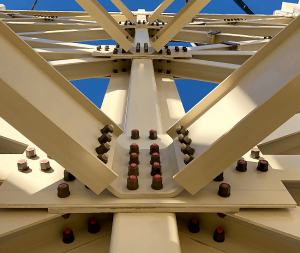What is Deflection in the Context of FRP?
In structural engineering, the term deflection refers to load-induced displacement that typically affects beam designs. It can be is a complicated value to calculate when considering the many variations of boundary conditions and materials. Additionally, beams may have constant cross-sections or tapered ends, which adds more complexity to the calculations. Also, materials can be homogeneous (i.e. structural steel) or non-homogeneous like a composite (i.e. FRP).
The use of fiber-reinforced polymers (FRP) to manufacture a growing range of structural applications is increasing. In this article, we will discuss the flexural properties of FRP, and how deflection affects the design of FRP beams.
How to Calculate Beam Deflection
A beam deflection calculation is a function of the amount of force required to cause a beam to bend. This requires a knowledge of the beam’s stiffness, which is defined by the formula of the modulus of elasticity multiplied by the beam’s moment of inertia (E x I). In beam design, a typical deflection limit is that deflection should not exceed the value of the beam span divided by 360 (L/360).

Even though FRP beams are less-stiff than steel beams, these same deflection limits exist for FRP structural members in FRP engineering applications. However, owing to their satisfactory strength, corrosion resistance, and reduced installation costs, FRP beams are increasingly used to replace steel beams. This gives FRP members an advantage over steel, whether you are dealing with structural parts or components comprising multiple parallel beams like gratings.
How to Reduce Beam Deflection
There are five primary strategies used to reduce beam deflection and improve flexural capacity. These are:
- Decrease load
- Shorten span
- Stiffen beams
- Increase beam depth
- Change beam support conditions
Obviously, it is not always possible to achieve each of these goals, so it is important to make improvements where it is most important. At Strongwell, we have taken each of these into account for previous applications requiring lower deflections, increased loads, longer spans, and so on.
FRP Beams: A Quick Case Study
When it is impossible to decrease the span, even when a longer span is necessary for larger structural applications, we have increased beam stiffness by improving our laminate design, which increases load capacity without increasing deflection. Additionally, FRP I-beams that feature thick flange construction can strengthen supports with or without the use of additional stiffeners.
FRP Solutions from Strongwell
At Strongwell, we pride ourselves on our ability to custom-build pultruded FRP solutions that consider our customers’ critical design parameters. If you need structural members or grating systems for high load areas, simply contact a member of the Strongwell team today.